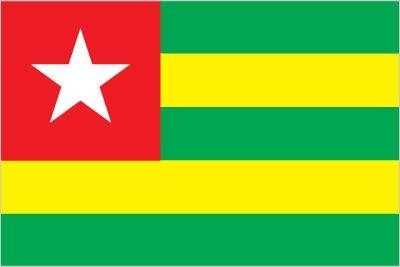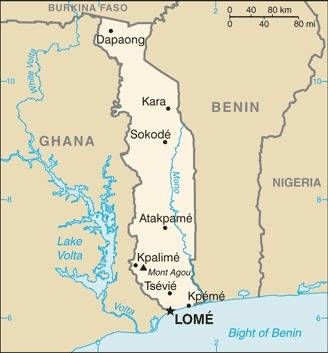226 Togo

Five equal horizontal bands of green (top and bottom) alternating with yellow stand for the five different regions of the country. Green symbolizes hope, fertility, and agriculture, while yellow represents mineral wealth and faith that hard work and strength will bring prosperity. A white five-pointed star symbolizing life, purity, peace, dignity, and Togo’s independence on a red square is in the upper hoist-side corner. The red square is meant to express the loyalty and patriotism of the people.
Flag courtesy of the CIA World Factbook

Map courtesy of the CIA World Factbook

Fishermen
Government
According to Britannica, the military coup d’état of 1967 abolished the constitution of 1963 and dissolved the National Assembly. A new constitution in 1992, since amended, established the president as head of state and a directly elected multiparty National Assembly, members of which serve six-year terms, with a limit of two terms. The president, who is elected by direct universal suffrage for a term of five years, appoints the prime minister from the parliament majority. In 2002 a two-term limit on the presidency was abolished, but it was reinstated in 2019; it was not, however, retroactive.
The country is divided into five régions, Maritime, Plateaux, Centrale, Kara, and Savanes, for the purposes of economic planning. The five régions are subdivided into préfectures, each of which is headed by a district chief assisted by a district council.
The local administrative apparatus is complemented by traditional authorities, which include traditional ethnic kings or chiefs, village chiefs, and heads of family groups. These traditional authorities play a role in the judicial system, dealing with certain questions of customary law. The judicial system is headed by a Supreme Court and consists of a number of law courts in which civil, commercial, administrative, and criminal cases are heard.
National Civil Aviation Agency (NCAA)
The Civil Aviation Department (DAC), now the National Civil Aviation Agency (NCAA), is responsible for organizing, coordinating and harmonizing air transport nationally and internationally. The phases in the evolution of civil aviation in Togo are as follows:
1. From ASECNA to DAC – ASECNA, a multinational organization responsible for the management of air navigation, was created by the Convention signed on December 12, 1959 in Saint-Louis, Senegal. From 1964 (date of Togo’s accession to ASECNA) to the creation of the DAC, aeronautical authority was exercised by the ASECNA Representative to the Togolese Republic who reported directly to the supervising minister by virtue of the provisions of Article 10 of the aforementioned Agreement (specific contract). According to this article, ASECNA managed on behalf of Togo the commercial activities of Lomé Tokoin airport.
2. Creation of the DAC – The DAC, the central administration responsible for implementing the aeronautical policy defined by the government and controlling all aeronautical activities carried out on Togolese territory, was created by Decree No. 73/12 of 17 January 1973 and attached to the Ministry of Public Works, Mines, Transport, Posts and Telecommunications. The DAC took over the prerogatives conferred by article 10 on ASECNA. The commercial operation of Lomé Tokoin airport was provided by the DAC until the creation of the SALT.
3. Creation of the NCAA – To provide civil aviation authorities with the skills and resources necessary to effectively carry out operator supervision tasks, regional and international bodies (UEMOA and ICAO respectively) have recommended that States create autonomous structures. It is within this framework that the National Civil Aviation Agency of Togo (NCAA) was created by Law No. 2007-007 of January 22, 2007 on the Civil Aviation Code, and following the adoption of appendix 19, the new law N°2016-011 of June 07, 2016 also relating to the civil aviation code was adopted and promulgated. The NCAA is a national public institution of an administrative nature, endowed with legal personality and management autonomy and placed under the supervision of the Minister in charge of civil aviation.
Airspace
SkyVector – Google Maps – ADS-B Exchange
ICAO countries publish an Aeronautical Information Publication (AIP). This document is divided into three parts: General (GEN), En Route (ENR) and Aerodromes (AD). ENR 1.4 details the types of airspace classes they chose to adopt from classes A through G.
Drone Regulations
Launch of digitalized civil drone services on the national public services portal
Advanced Air Mobility (AAM) Regulations & Policies
None found by the author.
However, should you, the reader, happen to stumble across something to the contrary, please email the author at FISHE5CA@erau.edu and you may be mentioned in the ACKNOWLEDGEMENTS section of this book by way of thanks for contributing to this free eBook!
Advanced Air Mobility (AAM) News
None found by the author.
However, should you, the reader, happen to stumble across something to the contrary, please email the author at FISHE5CA@erau.edu and you may be mentioned in the ACKNOWLEDGEMENTS section of this book by way of thanks for contributing to this free eBook!
Short Essay Questions
Scenario-Based Question
You have been hired by a Drone Startup Company. Your boss has immediately assigned this job to you.
They need you to prepare a one-page memo detailing the legalities of using a drone to film along the shoreline in Togo.
They need you to mention any national laws and local ordinances.
They specifically want to know what airspace (insert pictures) you will be operating in and whether or not you need an airspace authorization.
Does it matter whether or not you are a citizen of the country?
Lastly, there is a bonus for you if, as you scroll through this chapter, you find any typos or broken links!
Short Essay Questions
- What are the drone categories?
- How is registration addressed?
- How is remote ID addressed?
- What are the model aircraft rules?
- What are the commercial drone rules?
- Are there waivers or exemptions to the rules? If so, for what?
- Would you share a link to an interactive airspace map?
- How is BVLOS addressed?
- How can you fly drones at night?
- How can you fly drones over people?
- Where do you find drone NOTAMs?
- What are the rules for drone maintenance?
- What are the rules for an SMS program?
- What are some unique rules not mentioned above?
- What are the C-UAS rules?
- What are the AAM rules?

